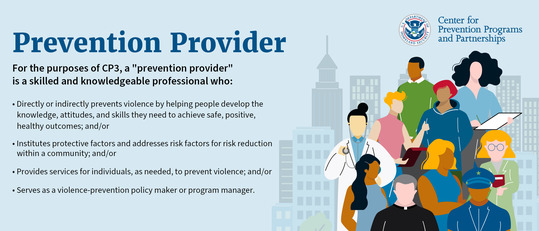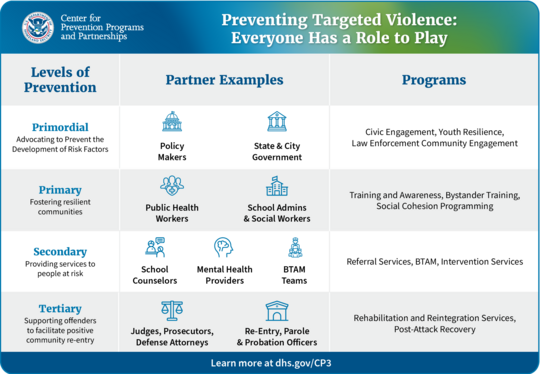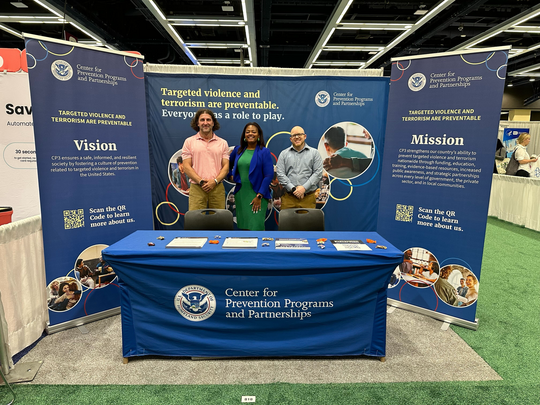|
Welcome to the Prevention Connection, a newsletter highlighting activities, resources, and information from the Department of Homeland Security (DHS) Center for Prevention Programs and Partnerships (CP3).
Please note, inclusion of articles, research, and references to non-DHS organizations are for informational purposes only and does not constitute an official endorsement by the U.S. Department of Homeland Security or Federal Government. do not imply a relationship with, affiliation with, sponsorship of, or endorsement by the Department, nor do they imply that editorial content has been authored by or represents the views or opinions of the Department, or to promote any commercial product or service, or in any other way that violates applicable law.
|
|
A Letter from Leadership
The Homeland Security Act of 2002, drafted in the aftermath of the attacks of September 11, 2001, provides that the primary mission of the Department of Homeland Security (DHS) includes to “prevent terrorist attacks within the United States.” Like many of my colleagues at CP3, the terrible events of 9/11 ultimately brought me to terrorism prevention work in the office that largely inherited this solemn mission. This month, we in CP3 honor the lives lost and those who survived.
The tragic event in Winder, GA, serves as a painful reminder that terrorism is not the only form of targeted violence plaguing the country, and that our approach to targeted violence prevention must work to decrease the likelihood of grievance-based violence and hate-fueled violence as well. Some of our younger colleagues at CP3 have been inspired to serve for this very reason, and so we are proud to host CISA’s School Safety Task Force to lead a conversation at our upcoming virtual Prevention Forum on 16 Sept. (details below), and to observe United Against Hate Week, Sept. 21 to 27.
DHS created CP3 to lead the Department’s efforts on targeted violence and terrorism prevention (TVTP). We recently published our “Approach to Targeted Violence and Terrorism Prevention,” to communicate our rationale for how CP3 strengthens our country’s ability to prevent targeted violence and terrorism nationwide through funding, education, training, evidence-based resources, increased public awareness, and strategic partnerships across every level of government, the private sector, and in local communities. Recently, I shared my personal thoughts and a description of CP3’s approach to prevention in an interview with the Combating Terrorism Center at West Point. I hope you'll take time to read the full interview in the CTC Sentinel.
It is partnerships with prevention providers that give us confidence and convince me it is time to turn our resources and energy toward prevention, not just responding to violent actors who have decided to commit such acts. Who are TVTP providers? Prevention providers include people already doing violence prevention work in their communities, including skilled professionals who directly or indirectly work to prevent suicide, violence against children, and intimate partner violence. They include individuals who help people develop the knowledge, attitudes, and skills to achieve safe, healthy, and empowered communities where violence is not an attractive way to advance an ideology, express a bias, or address a grievance.

One way CP3 works to enhance the national capacity for TVTP is to provide financial resources and technical assistance to grow the size and skill of the prevention provider community of practice. Just since June, CP3 has conducted more than 794 engagements with prevention providers, provided more than 20 trainings, and engaged with nearly 1,800 attendees in our virtual Prevention Forums. Additionally, site visits to the Prevention Resource Finder increased by more than 100% from June, due in part to our marketing efforts at national conferences. In a few weeks, we will announce grant awards totaling $18 million, under the TVTP Grant Program for fiscal year 2024.
Like other forms of violence, targeted violence and terrorism are preventable, but only if we take action. I would encourage all violence prevention providers to join in the TVTP community of practice. This is so important to consider as we enter the back-to-school season. The touchpoints that our nation’s prevention providers have with youth and young adults are critical to TVTP. Taking time to learn and understand the role you play is key, and I strongly encourage all prevention providers to attend our upcoming Prevention Forum Sept. 16 at 1 p.m.
In this issue of Prevention Connection, I invite you to learn more about CP3’s approach to international TVTP; the college and high school student winners of our experiential learning program, Invent2Prevent; and two of our TVTP grantees, Global Peace Foundation and the Polarization and Extremism Research and Innovation Lab (PERIL). Also, make sure you check out our three new Prevention Resources:
Please let me know how the resources help you in your efforts to prevent violence. You can always reach me by emailing CP3@hq.dhs.gov.
Thank you for your continued engagement and partnership; it is essential if we are to prevent the next act of targeted violence.

|
|
The Center for Prevention Programs and Partnerships’ Approach to Targeted Violence and Terrorism Prevention
As targeted violence and terrorism threats have evolved, so has our approach to mitigate such threats. The Center for Prevention Programs and Partnerships (CP3) invites you to learn more about our strategy by reading our newly published resource “The Center for Prevention Programs and Partnerships’ Approach to Targeted Violence and Terrorism Prevention”. This document provides an overview of the current targeted violence and terrorism threat landscape, the application and benefits of a public health-informed approach to prevention, and a summary of CP3’s strategy guiding its program priorities and investments.

Click the button below to read more about CP3's public health-informed approach to TVTP.
Director Braniff Talks TVTP in the CTC Sentinel
Center for Prevention Programs and Partnerships (CP3) Director Bill Braniff recently sat down with the Combating Terrorism Center (CTC) to discuss CP3's approach to targeted violence and terrorism prevention (TVTP). He delved deep into the CP3 mission, illustrating how each initiative builds and strengthens national capacity in violence prevention. Director Braniff highlighted the benefits of a public health-informed approach to TVTP. He shared how CP3 leverages research and strategic partnerships to improve and expand evidence-based prevention programs, collaborating with law enforcement, trauma-informed counselors, public health officials, mental health professionals, and more.
"We're working to normalize targeted violence prevention," Director Braniff said. "And that will go a long way to reducing the level of violence in the United States."
Read the full interview in the CTC Sentinel - Combating Terrorism Center at West Point.
Invent2Prevent (I2P), sponsored by the Center for Prevention Programs and Partnerships (CP3), empowers high school and university students to design and implement initiatives that increase the safety and resilience of their local communities. All I2P university finalists can apply for the DHS CP3 Targeted Violence and Terrorism Prevention (TVTP) Grant to bolster their projects’ impacts. As students return to school, would like to highlight the inspiring grant-winning teams. Since the program’s inception in 2021, I2P teams have secured more than $2.6 million in funding to support and sustain their community-based programs.
Global Peace Foundation Hosts Youth Leadership Development and Knowledge Exchange
Targeted Violence and Terrorism Prevention (TVTP) Grant recipient Global Peace Foundation (GPF) hosted a Youth Leadership Development and Knowledge Exchange event earlier this month, both in person in Marriottsville, Md., and virtually. This three-day event was designed for adults ages 18-30, community members, and youth-serving professionals from various organizations, agencies, and faith communities to enhance and facilitate resilience building and community strengthening.
PERIL at American University: Transforming Ideas into Action Against Violent Extremism
Targeted Violence and Terrorism Prevention (TVTP) Grant Program recipient Polarization & Extremism Research & Innovation Lab (PERIL) at American University used its funding to develop short-form video strategies aimed at preventing violent extremism. PERIL’s innovative approach took shape through the Violent Extremism Education and Resilience (VEER) program. This initiative, inspired by community needs, focuses on empowering local leaders and practitioners with skills to create impactful video content that fosters resilience and counters extremist narratives.
CP3 Strengthens Domestic Prevention Through International Engagements
In today’s global environment, no act of targeted violence or terrorism is solely a domestic concern. The Center for Prevention Programs and Partnerships (CP3) collaborates with experts around the world to share promising practices, learn from new research, and strengthen a global culture of targeted violence and terrorism prevention. CP3’s Strategic Engagement and Policy Implementation office operates on the principle that international partnerships can help prevention providers draw on the best evidence available and ensure a stronger future. In addition to learning from international partners, CP3 staff share expertise and resources to empower practitioners around the world.
Workplace Violence Prevention at U.S. Veterans Affairs Medical Center, North Las Vegas, Nev.
Over the summer, Center for Prevention Programs and Partnerships’ (CP3’s) Las Vegas Regional Prevention Coordinator and West Region Associate Director visited the North Las Vegas Veterans Affairs (VA) Medical Center to learn about its workplace violence prevention program and discuss opportunities for collaboration. The CP3 team met with Workplace Violence Prevention Program Manager Dr. Meredith Avedon and Deputy Program Manager Felicia Douville, LCSW. |
|
 |
CP3 Partners on Regional Targeted Violence Prevention Symposium in New York
On April 18-19, the Center for Prevention Programs and Partnerships (CP3) supported the Northeast Regional Targeted Violence Prevention Symposium, a multi-day event that brought together state partners and prevention providers across the region to discuss targeted violence prevention. The intent was to build a sustainable regional network to share best practices.
The event was led by the New York State Division of Homeland Security and Emergency Services (DHSES) and inspired by a similar event CP3 led with the John Jay College of Criminal Justice in March 2023. The 2023 event brought state and local leaders from New York and New Jersey together to discuss state and local strategies for preventing targeted violence.
The Symposium convened representatives from eight northeastern states, as well as experts from other parts of the country. Participants discussed challenges and opportunities within their violence prevention work. Topics included behavioral threat assessment and management, legal considerations in implementing prevention strategies, criminal justice and the public health approaches to prevention, referral pathways and bystander training, evaluation and metrics in targeted violence prevention, and strengthening communities through primary prevention.
CP3 looks forward to a continued partnership and collaboration in supporting more regional targeted violence prevention events in the future.
On May 29, in partnership with the Center for Prevention Programs and Partnerships (CP3) and EdVenture Partners, the New York City Public Schools Office of Safety and Youth Development, the Restorative Justice Team hosted the first-ever local Invent2Prevent competition.
This event was envisioned to raise awareness about and encourage greater participation across New York City Schools in Invent2Prevent, a U.S. Department of Homeland Security CP3 sponsored program that empowers students to create and implement campaigns aimed at preventing targeted violence and terrorism. Through this project based experiential learning opportunity, students gain valuable skills and insights into effective prevention strategies, contributing to safer, more resilient communities.
In total, 20 students from five schools, representing each borough, who all participated in the Spring 2024 I2P semester, formally presented their team projects to a panel of judges just like the national competition format.
Each project outlined practical approaches to address harmful content on-line, bullying, mental health, and create stronger connections to their community. Students also worked with local organizations to develop and implement their projects.
Central Park East High School won first place for their Salaam Sessions Podcast; Celia Cruz High School of Music earned second place for their Teen Mind Allies project combatting social isolation; and Urban Assembly Institute of Math and Science for Young Women won third place for their NYPD Engagement project, Bridging the Gap.
CP3 and NTER Uniting to Prevent Targeted Violence
The Center for Prevention Programs and Partnerships (CP3) conducted a National Threat Evaluation and Reporting (NTER) bystander awareness training for 28 diverse Uniters in Waukesha, organized by Urban Rural Action. The group included members of various ages, races, religions, and political views from Kenosha, Milwaukee, Racine, Walworth, and Waukesha counties. The training focused on community roles in preventing targeted violence. Held near the site of the 2021 Christmas parade tragedy, the event highlighted the community's resilience and dedication to violence prevention.
Building Partnerships with the Public Sector
On June 4, the Center for Prevention Programs and Partnerships (CP3) presented at the Detroit Corporate Security Symposium (CSS). Attendees included personnel from the private sector, state and local governments, as well as individuals supporting the homeland security mission. The Detroit CSS featured speakers from the Department of Homeland Security, the Federal Bureau of Investigation, other U.S. government entities, state and local agencies, and the private sector, addressing a wide range of homeland security topics. CP3 promoted secondary prevention by outlining the importance of incorporating behavioral threat assessment and management into the workplace to prevent future incidents of workplace violence.
The National Institute of Justice’s most recent issue of the NIJ Journal includes several articles on domestic radicalization, violent extremism, and terrorism. Highlights include articles discussing the role of trauma and mental health in prevention, practitioner perspectives on tertiary prevention, and evaluations assessing the effectiveness of prevention programs.
NIJ also recently published several papers that synthesize NIJ-funded research on the role of social networks in radicalization and prevention, prevention program evaluation, the role of the internet and social media on radicalization, and research on individuals who engage in violent extremism, mass shootings, and bias crimes.
The National Counterterrorism Innovation, Technology, and Education Center (NCITE) published a guide for families on how to recognize and find help for family members at risk of engaging in violent extremism. The guide provides an overview of risk and protective factors and information on how to report concerning behavior.
The Homeland Security Operational Analysis Center (HSOAC), operated by the RAND Corporation, conducted a landscape assessment on the threat to soft targets and crowded places, highlighting several research and investment priorities for improving security, including a recommendation to focus on prevention as both efficient and effective.
The Federal Bureau of Investigation (FBI), in collaboration with the Advanced Law Enforcement Rapid Response Training (ALERRT) Center at Texas State University, published a report analyzing active shooter incidents in 2023.
-
Exploring the Use of Three-Digit Call Lines - This report provides an overview of current research and programming efforts to integrate targeted violence and terrorism prevention information and practice into three-digit call lines, such as 211 and 311 assistance and information telephone numbers, as well as 911 and 988 emergency and crisis support lines.
-
State of Science Review - DHS S&T and research partners at NCITE finalized this resource that examines the current state and promising practices of threat assessment and threat management programs.
For more community support resources, evidence-based research, grant opportunities, information sharing, and training resources, visit the Prevention Resource Finder, your one-stop shop for federal resources to prevent targeted violence and terrorism.
A Note from the Interagency Editorial Board on the Prevention Resource Finder
On August 29, CP3 chaired the first-ever meeting of the interagency Editorial Board that governs the Prevention Resource Finder (PRF). The PRF is a government website for government produced and government funded community resources, training and funding opportunities, and evidence-based resources. In July, 16 resources were added to the PRF. The interagency will continue to add more resources every other month. Check out the latest resources.
Over the summer, the Center for Prevention Programs and Partnerships (CP3) team traveled to several events:
-
National Association of School Resource Officers 2024 National School Safety Conference
Phoenix, Arizona
-
National Association of County & City Health Officials NACCHO360
Detroit, Michigan
-
American Psychological Association 2024 Conference
Seattle, Washington
-
Association of Threat Assessment Professionals 2024 Threat Management Conference
Anaheim, California
-
Safe States 2024 Annual Injury & Violence Prevention Conference
Portland, Oregon

This fall, our booth will be making stops at the upcoming events:
-
2024 Annual National HBCU Week Conference
Philadelphia, Pennsylvania
-
International Association of Emergency Management Annual Conference
Colorado Springs, Colorado
-
American Public Health Association 2024 Annual Meeting & Expo
Minneapolis, Minnesota
Make sure to visit our team if you will be in attendance — we would love to talk with you about targeted violence and terrorism prevention!
|
|

The Center for Prevention Programs and Partnerships (CP3) is hosting our September Prevention Forum on Creating a Culture of Violence Prevention in K-12 Schools, along with CISA's School Safety Task Force. If you are involved in the K-12 community, please join us on September 16th to hear from expert panelists on how they work to cultivate positive, safe, supportive, and inclusive learning environments. We will also discuss strategies to implement and enhance bystander reporting programs plus resources available to K-12 communities. The forum will emphasize the role of community wellness in targeted violence prevention. Please register here and share with your networks!
|
|
Until Next Time
For more information on CP3 programs and initiatives, please visit http://www.dhs.gov/cp3
Visit the Prevention Resource Finder for information to help prepare for and prevent targeted violence and terrorism.
To learn about the Targeted Violence and Terrorism Prevention Grant Program, contact TerrorismPrevention@hq.dhs.gov
CP3 prioritizes privacy, civil rights, and civil liberties within DHS legal authorities and policy. CP3 works to ensure that its programs include fundamental constitutional and legal protections. CP3 does not engage in widespread data collection or activities like law enforcement investigations or intelligence gathering. CP3 does not engage in censorship or encourage or facilitate any censorship. Government censorship of viewpoints not only infringes on individuals’ constitutional rights, but it is also an ineffective tactic to prevent targeted violence and terrorism.
|
|
|
|
|